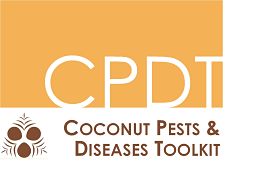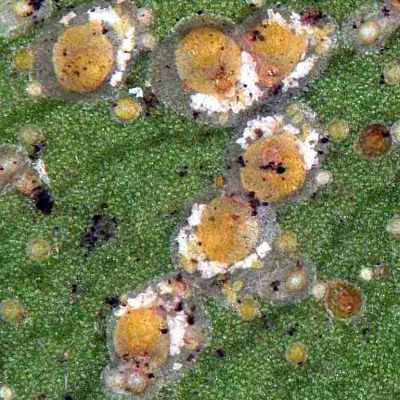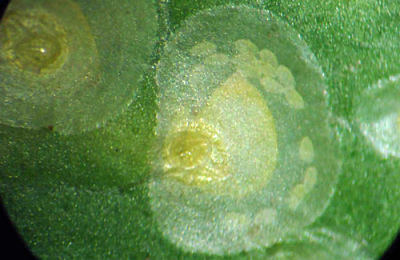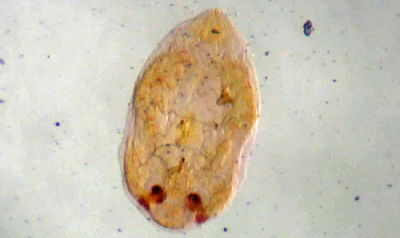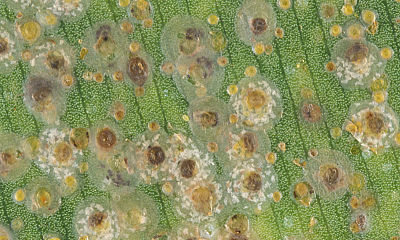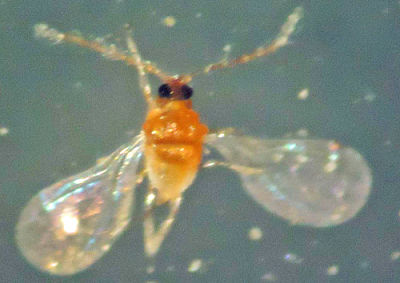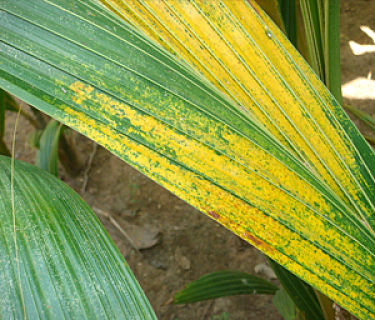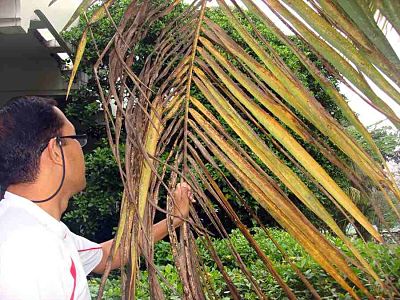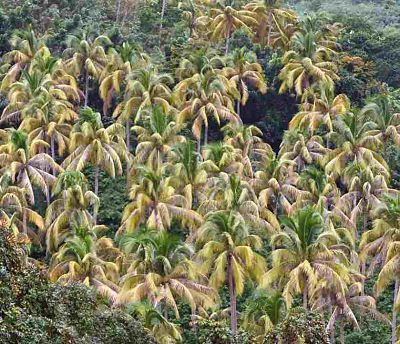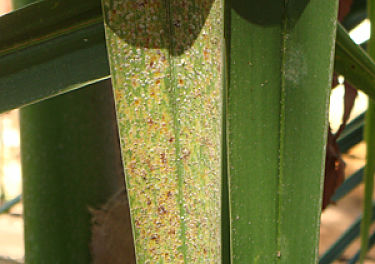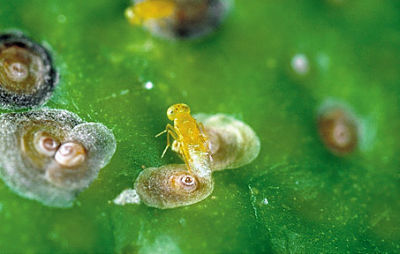Coconut scale & false scale
Coconut scale can become a serious pest of coconut and other important crops if not controlled. There is a high risk of population outbreaks.
Common nameCoconut scale |
Scientific nameAspidiotus destructor |
on this page: Life-cycle and identification : Symptoms : Impacts : Distribution : Prevention : Controlling coconut scale : Information sources and further reading
Life-cycle and identification
The coconut scale is an armoured scale insect with a waxy protective cover. They go through what is called an incomplete metamorphic life cycle. This consists of egg, nymphs and adult stages.
There will be many overlapping generations per year as the insects have a short life cycle of around 35 days (Aspidiotus destructor) or 45-55 days (Aspidiotus rigidus). Growth rates depend on weather and environmental conditions. Optimal conditions include a temperature of around 30°C with 65% humidity.
The scale insect can be found feeding on sap from the palm fruits, leaves and stems.
Colonies of the coconut scale are described as looking like miniature 'fried eggs'. Closely packed colonies are considered infestations.
Adult females have to be observed under a high resolution microscope on a slide (for diagnostic characteristics) to correctly identify the species of coconut scale.
EggsEggs are laid by adult females. Eggs can be found all around the adult female's body (A. destructor), or in a crescent shape (A. rigidus), under protective cover on the underside of leaves. The eggs are smooth and slender (0.22 mm long by 0.09 mm wide). The eggs are initially a whitish colour and slowly turn a pale yellow. Over a week Aspidiotus rigidus lays around 12 eggs while A. destructor lays 28-65. NymphsFemale nymphs have two growth stages (instars), while males have four. Nymphs newly hatched from the egg are called crawlers. This is the most mobile life stage. Crawlers have oblong shaped bodies. For 2 - 48 hours the crawlers move over and between leaf surfaces to find feeding sites. They will stay there for the remainder of their lives. The crawlers' waxy protective cover is a clear, light green to yellowish brown colour. They are tiny - around 0.23 mm long by 0.11 mm wide (A. rigidus is slightly larger and tougher). Nymphs have legs and antennae with a pair of short appendages at the end of their body. FemalesThe second female growth stage (instar) is also oval and a clear pale yellow. However, the nymphs are now larger (0.6-1.1 mm long). The second stage lasts for 8-10 days. MalesMale nymphs look like the second female instar but half way through development start to show male characteristics. The protective cover becomes more egg-shaped and red-brown. Under the second instars protective cover, the male will undergo non-feeding pre-pupal and pupal stages before becoming an adult. AdultsFemalesAdult females have a flat and broad, clear oval or circular cover ~2.0 mm in diameter). In the centre of this cover there is a pale exuviae (skins shed from previous growth stages). The adult female is pear-shaped and 0.7-1.2 mm in length with hardened (sclerotised) plates on its back. The long plates on the flat and fringed body are visible under a micrtoscope with three pairs of lobes. MalesAdult males look very different to females. The males look more like a small fly than a scale. The males have two-wings, antennae and three pairs of legs. They are a reddish colour (A. destructor) or yellow (A. rigidus) and have a pair of long appendages at the end of their body. The males have no mouthparts, and can not feed so have a short lifespan. Once mature the males fly off to mate with females, attracted by the pheromones the females produce. However, A. destructor females can also reproduce without male fertilisation. The same is speculated for A. rigidus. |
Aspidiotus rigidus adult female, showing the eggs in a crescent shape under her cover (© Merle Shepard and Gerald Carner, Clemson University)
Aspidiotus adult female with a flat, clear oval cover with pale exuviae (skins shed from previous growth stages) near the centre surrounded by eggs. Note the pear shaped body (© Salahud din, University of Florida)
Aspidiotus destructor red-brown male pupa, removed from its cover (© Salahud din, University of Florida)
Yellowish brown coloured Aspidiotus nymphs with little to no cover, among adult females (A. destructor) (© Lyle Buss, University of Florida)
Aspidiotus adult male that looks like a small fly (© Salahud din, University of Florida) |
Symptoms
The coconut scale causes yellow spots with possible small dents at the site of feeding. The symptoms could be caused be a toxic saliva produced when feeding. These toxins are transmitted into the plant.
|
Yellow spots concentrated on an area of a leaflet surrounded by green healthy tissues. Note red-brown spots starting to appear (© TNAU) |
|
Leaf tissues looking yellowed or brown and wilted (© Merle Shepard and Gerald Carner, Clemson University) |
|
The yellowing of the palm can start by being concentrated in one section of the leaflet surrounded by unaffected green areas. The leaf tissues may then look twisted, wilted and dry. Alternatively the whole leaflet will turn yellow then brown and fall off. Entire fronds may be damaged and fall off, which can be followed by the death of the crown. Whole plantations may be symptomatic with many yellowed crowns (see image on right). The yellowing of palms can be seen from a distance. When infestations are severe, a crust of scale insects can form over the whole leaflet (usually on the underside - see image below right). The crust may also form over frond stems, flower spikes and young nuts that are infested. Seedlings and young palms are likely to die when infestations are severe. The nuts may also turn yellow-brown, have stunted growth and fall before maturing. Coconut milk may have a noticeable sour taste. ImpactsThe coconut scale was considered a serious pest of coconut and other important crops until biological controls were put in place to reduce populations. However, before this copra production was reduced from 1400 to 500 tons annually in Principe (off the west coast of Africa). A reduction in yields of at least 25% over 2-3 years occurred after an outbreak in Côte d'Ivoire. If the coconut scale was introduced in to new regions, outbreaks could severely reduce coconut production. The feeding of the coconut scale causes cosmetic damage to coconuts said to reduce the products quality and making it less marketable. The stunted growth and early fall of nuts, producing less copra and a sour milk also reduces the economic outputs. This youtube video from the Philippines has information on symptoms and impacts of coconut scale. |
A coconut plantation showing many yellowed palms (© Merle Shepard and Gerald Carner, Clemson University)
A leaf with a crusted surface due to a heavy coconut scale infestation (© TNAU)
Young coconuts infested by coconut scale colonies can have cosmetic damage (© Bernhard Loehr, ICIPE, Bugwood.org) |
Distribution
Aspidiotus rigidus is found in Indonesia and the Philippines (provinces).
Aspidiotus destructor is more widely found in within Asia, Africa, America (Central, North, South and the Caribbean), Europe and Oceania.
In the Pacific A. destructor is reported in American Samoa, Fiji, French Polynesia, New Caledonia, Papua New Guinea, Samoa and Solomon Islands, Vanuatu, Wallis & Futuna.
Please check with your local biosecurity / quarantine or SPC for up-to-date distribution information.
Prevention
Most importantly, the International Guidelines for transfer of coconut germplasm should be strictly followed to prevent pests and diseases being moved to new locations.
Coconut scale is known to be dispersed by birds, bats and insects as well as wind.
This species is highly polyphagous (attacks many different crops) and therefore can easily be re-introduced, even if it is successfully controlled on the primary host crop.
Aspidiotus destructor has a wide distribution, though is not currently in Tonga.
It is recommended to follow The FAO/IBPGR Technical Guidelines for the Safe Movement of Coconut Germplasm.
For general information on preventing pests and diseases of coconut, see the Prevention section.
Controlling coconut scale
We strongly recommend an integrated pest management (IPM) approach to the control of all insects, where possible. This is a combination of methods (pesticides, physical controls such as site hygiene, and biological controls) to minimise the use of pesticides and minimise the cost of control.
Integrated Pest Management (IPM)
The goal of IPM is to keep pest populations to a level below which they cause economic harm. IPM involves using multiple control options together for the economic control of pests (i.e. cultural, natural and chemical).
In an agricultural context the Food and Agriculture Organization defines IPM as "the careful consideration of all available pest control techniques and subsequent integration of appropriate measures that discourage the development of pest populations and keep pesticides and other interventions to levels that are economically justified and reduce or minimize risks to human health and the environment. IPM emphasizes the growth of a healthy crop with the least possible disruption to agro-ecosystems and encourages natural pest control mechanisms".
Cultural
Infected fronds should be cut and burned at the early stage of infestation, if possible. The waste should be disposed of properly to avoid the spread of any surviving scale insects and to reduce breeding sites.
It might be useful to limit the use of plant fertilisers, as excessive use has been said to play a part in outbreaks.
Sanitation efforts will only be effective early in an infestation.
NaturalWasp parasitoids have been introduced from Java to successfully control A. destructor. These parasitoid predators include Aphytis melinus and Aphytis lingnanensis in Fiji and the Philippines. Argentina, California and Hawaii have also introduced Aphytis melinus and Comperiella bifasciata. Ladybird beetles (Coccinellidae) predators from Trinidad have also been introduced. These include Chilocorus species, Telsimia nitida, Pseudoscymnus anomalus, Cryptognatha species (Cryptognatha nodiceps and later Cryptognatha gemellata). Rhyzobius satelles is useful when ants are not tending scale insects for their honeydew. |
The parasitic wasp, A. melanus laying eggs on a scale (© Jack Kelly Clark, formerly ANR Communication Services, University of California Statewide IPM Program) |
Chilocorus, Cryptolarmus montrouzieri, Rhyzobius and Scymnus have been used to control A. destructor in the Solomon Islands.
Pseudoscymnus anomalus has been used to control A. destructor in Micronesia and Vanuatu.
Natural controls of A. rigidus have not been as successful as A. destructor controls. However, in the Philippines a Comperiella species has been successful, with a parasitism rate of 65-90%.
Parasitoid wasps in Indonesia include Spanioterus crucifer, Aphytis chrysomphali, and Comperiella unifasciata. Encarsia citrina in Bali is suspected to attack A. rigidus. Predatory beetles are seen attacking A. rigidus but these do not control outbreaks or have little impact.
Java has not experienced outbreaks of A. rigidus, though it is unknown whether this is because there are natural predators controlling them or what those predators might be (outside of the wasp parasitoids already mentioned).
Chemical
Pesticides are not generally recommended as they require intensive labour. Pesticides are costly and can be harmful to the natural environment. If natural predators are present, these will also be harmed by pesticides.
Insecticidal oils and soap solutions applied directly to the coconut scale can be useful but only at the crawler stages. which are more susceptible with less waxy coverings. For detailed instructions, visit PestNet.
Information sources and further reading
CABI. 2018. Aspidiotus destructor (coconut scale). [ONLINE]
Molet. 2015. CPHST Pest Datasheet for Aspidiotus rigidus. USDA-APHIS-PPQ- CPHST. [ONLINE]
PestNet. 2017. Coconut (false) scale (348). [ONLINE]
PestNet. 2017. Coconut scale (104). [ONLINE]
Plantwise. 2018. Coconut scale (Aspidiotus destructor). [ONLINE]
Salahud din, Arthurs (UF). 2018. Featured Creatures; Coconut scale (Aspidiotus destructor). [ONLINE]
TNAU. 2018. Pest of Coconut; Scale Insect: Aspidiotus destructor. [ONLINE]
Watson, Adalla, Shepard, Carner. 2015. Aspidiotus rigidus Reyne (Hemiptera: Diaspididae): a devastating pest of coconut in the Philippines. Agricultural and Forest Entomology. 17:1-8. [ONLINE]
